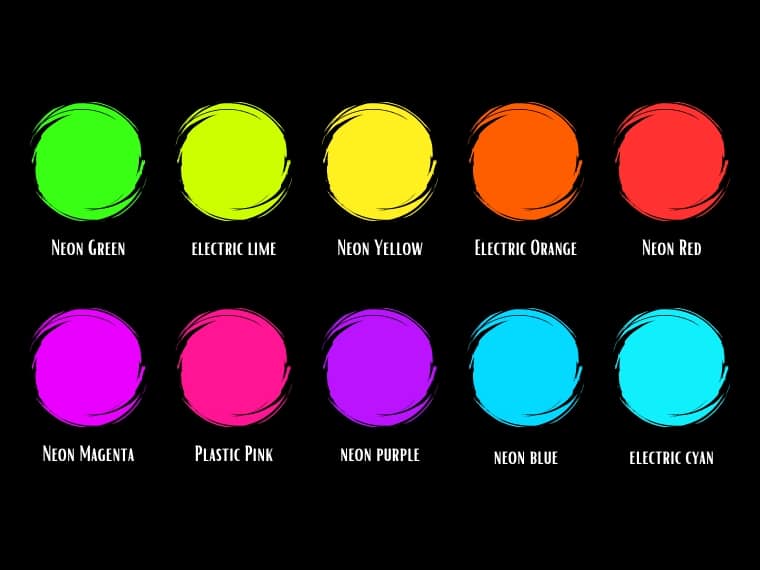Neon colors, also known as fluorescent colors, were popular in the 1990s. But what is the story behind these neon signs? Where do they originate? Today you will learn everything you need to know about neon-colored lights.
They do, however, come in a variety of forms nowadays, including nail polish, hair dye, clothing, and even shoes.
Although they have been popular throughout the ages, their brilliance is hard to find in nature.
Let’s find out more about neon colors and their rich history.
What are Neon Colors?
Neon colors are bright, bold, and highly saturated shades of primary and secondary colors that appear incredibly vivid and intense. Thus, neon colors include various types of red, green, blue, yellow, orange, and purple.
Neon colors stand out from traditional colors because they reflect more light.
Neon colors were first introduced in the 1920s but became especially popular in the 1980s and 1990s. They are named after the neon gas used in neon signs, even though they are not made using neon gas.
Instead, they are made using a combination of other gases, such as argon and helium, as well as fluorescent coatings that create the bright, glowing effect.
Some neon colors include neon pink, neon green, neon yellow, and neon orange. These colors are used to attract attention. They are also used to create contrast and highlight information.
Therefore, neon colors are often seen in signs, advertising, and fashion.
Neon Colors versus Fluorescent Colors
Neon and fluorescent colors are often used interchangeably, but they are different.
Neon colors are bright and bold, but they do not emit light. Instead, they are created using pigments that reflect light, making them appear extremely bright and eye-catching. Neon colors are typically used in signs, clothing, and art.
Fluorescent colors, on the other hand, do emit light. They contain phosphors that absorb energy from light or other sources and emit it as visible light. This makes fluorescent colors appear even brighter and more intense than neon colors. As a result, fluorescent colors are often used in lighting, safety gear, and art.
While neon and fluorescent colors are eye-catching and vibrant, their differences lie in how they create brightness. Neon colors reflect light, while fluorescent colors emit light.
Are Neon Colors on the Color Wheel?
Neon colors are not typically found on a traditional color wheel because they are just bright shades of primary and secondary colors.
A color wheel generally displays the primary, secondary, and tertiary colors (or intermediate colors). More specifically, three primary colors, three secondary colors, and six intermediate colors.
What Makes a Color Neon?
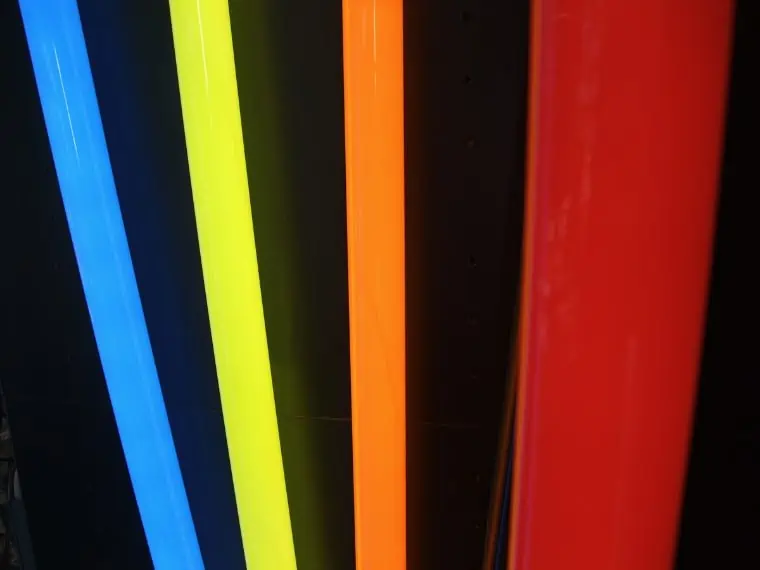
A color is considered neon when it is extremely bright and highly saturated, with a vivid, almost glowing appearance. However, this is a subjective term, and there is no precise definition of what makes the color neon. Some common characteristics of neon colors include:
- Extremely bright and intense
- Highly saturated and vibrant
- Often seen in shades of pink, orange, yellow, green, and blue
- Tend to have a slightly bluish or cool undertone
Types of Neon Colors
Although “neon color” is frequently used in art and design to describe an extremely bright color, in science, the term refers to a gas element that produces only a reddish-orange color.
Here are the primary neon colors with their names and Hex codes:
Neon Green
Hex: #39FF14
UFO Green
Hex: #7FFF00
Electric Lime
Hex: #CCFF00
Chartreuse Yellow
Hex: #DFFF00
Neon Yellow
Hex: #FFF01F
Electric Orange
Hex: #FF5E00
Neon Red
Hex: #FF3131
Neon Magenta
Hex: #EA00FF
Plastic Pink
Hex: #FF1493
Neon Pink
Hex: #FF44CC
Neon Purple
Hex: #BC13FE
Hot Purple
Hex: #A420D0
Proton Purple
Hex: #8A2BE2
Neon Blue
Hex: #1F51FF
Electric Blue
Hex: #7DF9FF
Electric Cyan
Hex: #0FF0FC
Neon green and electric cyan are considered to be the brightest neon colors out there.
Like any other color, neon colors have complementary colors.
For example, electric orange and neon blue provide color harmony because they are complementary colors.
Neon Color Meanings
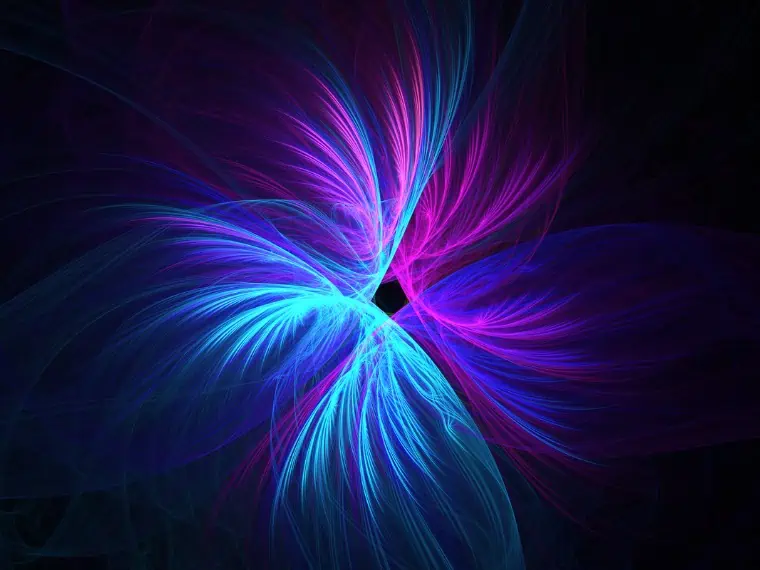
Neon colors are often associated with fun, excess, and frivolity. However, because they are brash and very bright, neon colors have not always been associated with good taste.
Furthermore, neon colors have been linked to fluorescent signage, reinforcing their connection to nightlife and clubs.
On the other hand, neon colors can be associated with danger or warning due to their usage in signage and high-visibility clothing.
Neon red is a stimulating and exciting color associated with energy, vitality, power, and action.
Electric orange is a bright orange shade that evokes optimism, excitement, and enthusiasm.
Neon yellow is associated with happiness and joy. Moreover, neon yellow has meanings of optimism, hope, and fun.
Neon pink is a bright pink shade associated with romance, love, and lust.
Proton purple is actually similar to violet and is associated with creativity and confidence.
Neon purple is associated with royalty, ambition, and luxury. On the other hand, neon purple is associated with extravagance, pride, and magic.
Electric blue is a vibrant shade of blue that resembles aqua or cyan. This vibrant color evokes energy, action, and excitement.
Neon blue, like all shades of blue, is associated with calm and relaxation.
What is Neon?
The noble gas neon was discovered by British chemists Sir William Ramsay and Morris Travers in 1898.
Neon is a colorless, odorless gas found in small amounts in the Earth’s atmosphere. This noble gas is known for its unique ability to emit a bright, glowing light when an electrical current is passed through it. This property makes it ideal for use in signs and lighting.
Who Invented the Neon Light?
Two British chemists, Sir William Ramsay and Morris Travers, discovered neon in 1898. They were studying the gases produced during air liquefaction when they found neon, a natural gas in our atmosphere.
The properties of neon were quickly recognized as being unique and useful, particularly its ability to emit a bright, glowing light when an electrical current is passed through it.
This led to the development of neon lighting, first used commercially in 1910 for advertising signs.
The first neon signs were created by Georges Claude, a French engineer who developed a way to store neon gas in small tubes and pass an electrical current through them to create a glowing effect. This occurred in 1910 at the Paris Motor Show.
Neon lighting quickly became famous for its eye-catching brightness and distinctive appearance.
How Do Neon Signs Get Their Colors?
The neon signs are made of glass tubes with electrodes at each end, through which the electric current passes. So inside the tube, there is a quantity of neon or argon, which, once connected to high voltage current, produces a red color. However, there are about 150 colors used in these tubes.
Although it is a generic name, not all neon tubes contain the neon element. Most fluorescent tubes contain a small amount of magnesium and inert gas inside the glass tube. This interior is also coated with a layer of phosphor powder.
When electricity passes through the metal contacts at the ends of the tube, excitation of the magnesium inside the tube takes place. With this process, energy is released by the magnesium atoms in the form of ultraviolet light. This is not visible to the human eye.
When this light reaches the phosphor layer, it starts to glow. Thus, fluorescent light appears.
What Colors Do Noble Gases Produce?
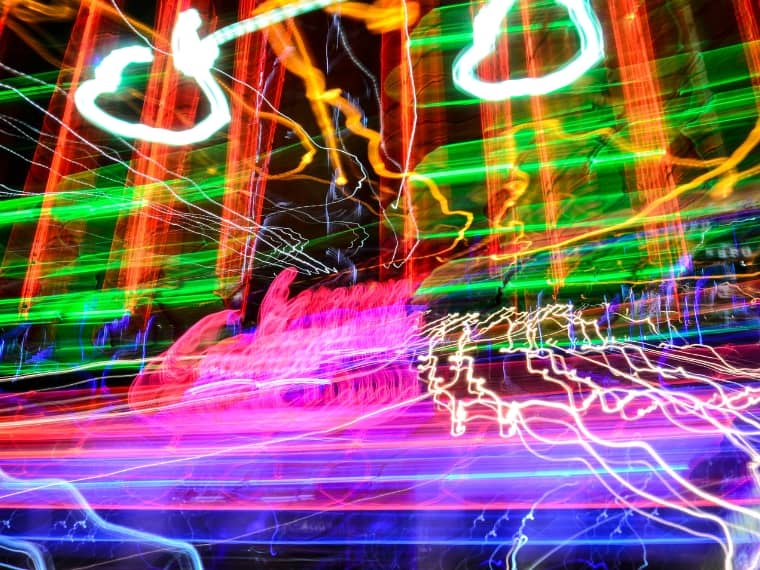
Noble gases can produce different bright colors in light. For example, neon produces red-orange hues, while xenon produces gray or bluish-gray colors.
Thus, noble gases are used differently to create various colors.
Here are the main types of noble gases and their resulting colors:
- Neon — Red, orange, red-orange
- Argon — Violet to pale blue
- Helium — Orange, red, pink, pink-red
- Krypton — Off-white, green, yellow
- Xenon — Off-white, gray, blue, green
There are also other gases that are not used in the technology because they are highly radioactive. An example is radon. This type of gas produces a yellow glow.
History of Neon Signs
Neon signs are the most popular type of neon, lighting up streets worldwide for decades. The idea came from astronomer Jean Picard as early as 1675, when he discovered a glow in mercury barometer tubes.
Although he didn’t understand the cause of the glow, scientists began researching this type of lighting. This research led to the development of neon lights.
In 1898, Sir William Ramsay and Morris Travers discovered neon while researching gases produced during air liquefaction.
Thanks to their work, in 1910, Georges Claude presented the first neon lamp at the Paris Motor Show. Thus, the French engineer was the first to store neon gas in a small tube and pass an electric current through it to create the popular glowing effect.
It was called “neon” because the term is related to the word “neos,” which means “the new gas.”
In 1923, the same Georges Claude brought neon gas signs to the United States. His company was called Claude Neon.
Although it seems unbelievable, Earle Anthony bought two neon signs for $24,000. He used them at his Packard car dealership.
Over time, these signs became increasingly desirable, especially by companies to attract the attention of potential customers. Thus, more and more manufacturing companies appeared, and their prices dropped.
Neon Color History
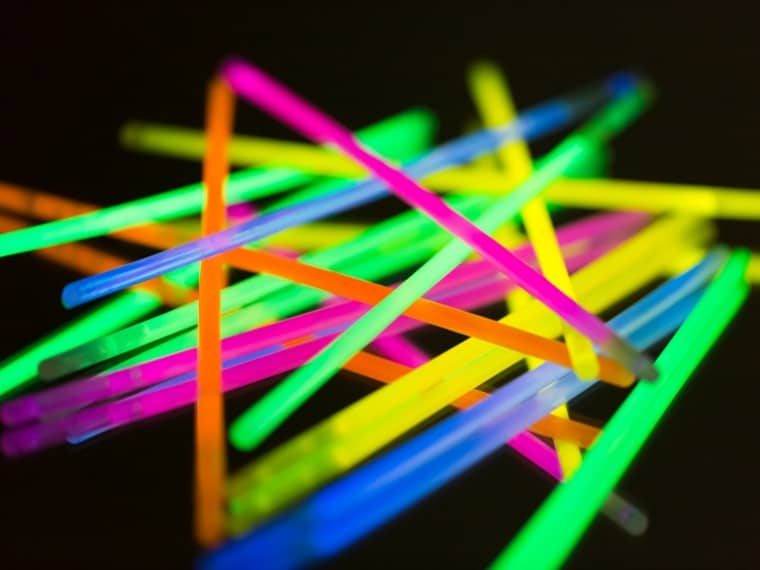
Trends change over time. Certainly, colors are no exception to this rule. Thus, neon colors suffered a lot of changes throughout history, which increased their popularity.
German physicist Heinrich Geissler first sealed glass tubes with two electrodes. The two electrodes caused an electric current. This caused the gases inside the tube to glow.
In 1898, the term “neon” was used for the first time. Two British scientists, while studying the gases produced during the liquefaction of air, discovered neon. As air liquefied, they separated this gas and named it ‘neon’. The word comes from ‘neos’, which means ‘new gas.’
In 1910, Georges Claude – a French engineer, developed a way to store neon gas in small glass tubes and pass an electric current through them to create the glow effect.
Thus the first neon tube was born.
Five years later, he sold his first two neon tubes to a car dealership in Los Angeles for $24,000. So neon tubes arrived in the United States in 1915.
In the 1950s, a sign design company, Artkraft Strauss, began displaying neon signs in New York Times Square. Later, the company grossed over $100,000 in revenue from its sales.
In art, neon colors were first used by Andy Warhol, who painted a pink neon cow with a yellow background. At the time, he said it was one of the most modern things.
Keith Sommers also created some extraordinary pieces using lit-up neon sculptures. One of his works is located at the New Munich International Airport.
Since the 1980s, neon colors have also been introduced into pop culture, from accessories to clothing.
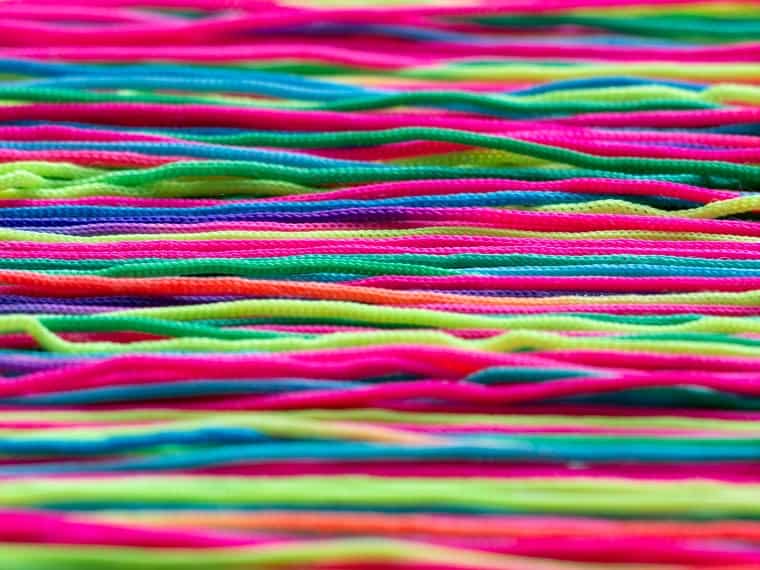
In the 1990s, glow sticks gained popularity, especially at parties.
In 2007, the sneaker company created a collection of neon shoes that glowed in the dark.
Although neon colors have lost their popularity today, they come in many forms, from make-up, nail varnish, and hair dye to clothing.
Last Words on Neon Colors
Popular in the 1900s, neon colors have captured people’s attention for over a century. They are vibrant and eye-catching. Moreover, they easily attract attention and contribute to the creation of a fun and lively environment.
Whether you work in graphic design or are a fashion enthusiast, you can make your own neon color palette out of bright shades of red, orange, yellow, green, blue, and purple.
Did you like this neon color article? Help us spread the word and share it with your friends who might be interested.

